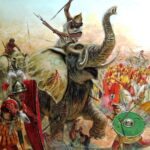Romans rarely used elephants in battle. Several pieces captured on Pyrrhus were present at the triumph of Manius Curius Dentatus in Rome in 275 BCE. However, it is not known what happened to these animals later. Perhaps they shared the fate of about 140 elephants captured by Lucius Metellus Pontyfex in Sicily in the battles with the Carthaginians, who died in the arena after the triumph of the victorious leader. As you can see, the chiefs of the city on the Tiber did not initially appreciate the value of these animals. At the turn of the 3rd and 2nd centuries BCE
The Romans briefly used elephants on a larger scale. They were used for the first time in the Second Macedonian War (in 200-197 BCE), among others under the battle of Cynoscephalae. They came from Africa and were either captured by the Carthaginians or donated by the Numidians, as was the case in 198 BCE when the Numidian king Masinissa gave Rome 10 elephants and in 153 BCE when he gave the city on the Tiber another 10 of these giants. These animals were also used during the Spanish War in 181-133 BCE. In Italy, elephants enjoyed the fame of a “double-edged sword”, which may partly explain the reason why the Romans were reluctant to these creatures. Appian also shared this view, calling them common enemies of both warring sides. It is worth mentioning Claudius Aelianus, who wrote that the fighting elephants were watered with wine, which could have been aimed at reducing the stress on the animals. The Roman recalls: “The elephant of the herd has adapted to drink water. But the elephant who fights in war drinks wine”. Elephant trainers (mansuetarii) have been known to water the animals with a decoction of rice and reeds before sending them to the arena. Reportedly, it took 10 to 27 litres of a drink containing 7% alcohol to get drunk on a three-tonne animal.







